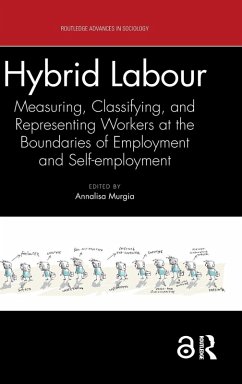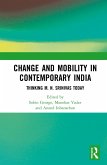Hybrid Labour
Measuring, Classifying, and Representing Workers at the Boundaries of Employment and Self-employment
Herausgeber: Murgia, Annalisa
Hybrid Labour
Measuring, Classifying, and Representing Workers at the Boundaries of Employment and Self-employment
Herausgeber: Murgia, Annalisa
- Gebundenes Buch
- Merkliste
- Auf die Merkliste
- Bewerten Bewerten
- Teilen
- Produkt teilen
- Produkterinnerung
- Produkterinnerung
This book advances the debate on the hybrid areas of labour by taking the case of work arrangements that destabilise the dichotomies between standard and non-standard work, and between self-employment and dependent employment.
Andere Kunden interessierten sich auch für
![Work and the Enterprise Culture Work and the Enterprise Culture]() Work and the Enterprise Culture139,99 €
Work and the Enterprise Culture139,99 €![Disneyization of Drug Use Disneyization of Drug Use]() Tim TurnerDisneyization of Drug Use161,99 €
Tim TurnerDisneyization of Drug Use161,99 €![Diversity and Inclusion in Japan Diversity and Inclusion in Japan]() Diversity and Inclusion in Japan166,99 €
Diversity and Inclusion in Japan166,99 €![International Disability Law International Disability Law]() Coomara PyaneandeeInternational Disability Law180,99 €
Coomara PyaneandeeInternational Disability Law180,99 €![Redressing Everyday Discrimination Redressing Everyday Discrimination]() Karla PortillaRedressing Everyday Discrimination190,99 €
Karla PortillaRedressing Everyday Discrimination190,99 €![Change and Mobility in Contemporary India Change and Mobility in Contemporary India]() Change and Mobility in Contemporary India180,99 €
Change and Mobility in Contemporary India180,99 €![The Concept of Race in International Criminal Law The Concept of Race in International Criminal Law]() Carola LingaasThe Concept of Race in International Criminal Law180,99 €
Carola LingaasThe Concept of Race in International Criminal Law180,99 €-
-
-
This book advances the debate on the hybrid areas of labour by taking the case of work arrangements that destabilise the dichotomies between standard and non-standard work, and between self-employment and dependent employment.
Produktdetails
- Produktdetails
- Verlag: Taylor & Francis Ltd (Sales)
- Seitenzahl: 298
- Erscheinungstermin: 3. Februar 2025
- Englisch
- Abmessung: 239mm x 162mm x 22mm
- Gewicht: 608g
- ISBN-13: 9781032405629
- ISBN-10: 1032405627
- Artikelnr.: 71846774
- Herstellerkennzeichnung
- Libri GmbH
- Europaallee 1
- 36244 Bad Hersfeld
- gpsr@libri.de
- Verlag: Taylor & Francis Ltd (Sales)
- Seitenzahl: 298
- Erscheinungstermin: 3. Februar 2025
- Englisch
- Abmessung: 239mm x 162mm x 22mm
- Gewicht: 608g
- ISBN-13: 9781032405629
- ISBN-10: 1032405627
- Artikelnr.: 71846774
- Herstellerkennzeichnung
- Libri GmbH
- Europaallee 1
- 36244 Bad Hersfeld
- gpsr@libri.de
Annalisa Murgia is Associate Professor of Sociology at the Department of Social and Political Sciences of the University of Milan, where she is also the scientific coordinator of the Research Centre GENDERS (https://gender.unimi.it/). Her research interests focus on precariousness, emerging forms of organising, and gender differences in organisations. She is the PI of the ERC project SHARE, 'Seizing the Hybrid Areas of work by Re¿presenting self¿Employment' (2017-2023, https://ercshare.unimi.it/). She recently cöedited the book Faces of Precarity: Critical Perspectives on Work, Subjectivities and Struggles (2022).
Preface
PART 1. The State of the Art
1. Working at the Boundaries: An Introduction to Solo Self-employment
2. A Statistical Portrait of the Workers at the Boundaries of Employment
and Self-employment in Europe: Who Are They and What Do They Do?
3. Regulating Labour at the Border between Employment and Self-employment:
An Enduring Challenge
4. When Labour Diversifies, Its Collective Representation Does Too
PART 2. Epistemological and Methodological Approach
5. Hybrid as an Epistemological and Methodological Approach
6. Research Contexts and Methods
PART 3. SHARE: A Transdisciplinary and Multi-Method Study Conducted in Six
European Countries
7. Deconstructing Labour Statistics by Reconstructing the Concepts of
Autonomy and Dependency
8. Hybrid Work in Hybrid Organisations. Labour Law and New Organisational
Methods
9. A Comparative Ethnography on the Collective Representation in the Hybrid
Areas of Labour
10. Hybrid Cooperatives: An Alternative to Self-employment Ensuring
Autonomy, Security, and Solidarity
11. If Work Is Hybrid, Are Workers Hybrid Too? Old and New Challenges for
Approaching Heterogeneous Workers
12. Hybrid Practices of Organising: How Workers Mobilise between Employment
and Self-employment
13. Hybrid Forms of Organising Are Growing and so Are Workers' Networks:
The Emergence of National and Transnational Alliances
14. A Hybrid Attempt to Regulate Labour: Recent Developments under the
European Union's Legal Framework
Afterword
PART 1. The State of the Art
1. Working at the Boundaries: An Introduction to Solo Self-employment
2. A Statistical Portrait of the Workers at the Boundaries of Employment
and Self-employment in Europe: Who Are They and What Do They Do?
3. Regulating Labour at the Border between Employment and Self-employment:
An Enduring Challenge
4. When Labour Diversifies, Its Collective Representation Does Too
PART 2. Epistemological and Methodological Approach
5. Hybrid as an Epistemological and Methodological Approach
6. Research Contexts and Methods
PART 3. SHARE: A Transdisciplinary and Multi-Method Study Conducted in Six
European Countries
7. Deconstructing Labour Statistics by Reconstructing the Concepts of
Autonomy and Dependency
8. Hybrid Work in Hybrid Organisations. Labour Law and New Organisational
Methods
9. A Comparative Ethnography on the Collective Representation in the Hybrid
Areas of Labour
10. Hybrid Cooperatives: An Alternative to Self-employment Ensuring
Autonomy, Security, and Solidarity
11. If Work Is Hybrid, Are Workers Hybrid Too? Old and New Challenges for
Approaching Heterogeneous Workers
12. Hybrid Practices of Organising: How Workers Mobilise between Employment
and Self-employment
13. Hybrid Forms of Organising Are Growing and so Are Workers' Networks:
The Emergence of National and Transnational Alliances
14. A Hybrid Attempt to Regulate Labour: Recent Developments under the
European Union's Legal Framework
Afterword
Preface
PART 1. The State of the Art
1. Working at the Boundaries: An Introduction to Solo Self-employment
2. A Statistical Portrait of the Workers at the Boundaries of Employment
and Self-employment in Europe: Who Are They and What Do They Do?
3. Regulating Labour at the Border between Employment and Self-employment:
An Enduring Challenge
4. When Labour Diversifies, Its Collective Representation Does Too
PART 2. Epistemological and Methodological Approach
5. Hybrid as an Epistemological and Methodological Approach
6. Research Contexts and Methods
PART 3. SHARE: A Transdisciplinary and Multi-Method Study Conducted in Six
European Countries
7. Deconstructing Labour Statistics by Reconstructing the Concepts of
Autonomy and Dependency
8. Hybrid Work in Hybrid Organisations. Labour Law and New Organisational
Methods
9. A Comparative Ethnography on the Collective Representation in the Hybrid
Areas of Labour
10. Hybrid Cooperatives: An Alternative to Self-employment Ensuring
Autonomy, Security, and Solidarity
11. If Work Is Hybrid, Are Workers Hybrid Too? Old and New Challenges for
Approaching Heterogeneous Workers
12. Hybrid Practices of Organising: How Workers Mobilise between Employment
and Self-employment
13. Hybrid Forms of Organising Are Growing and so Are Workers' Networks:
The Emergence of National and Transnational Alliances
14. A Hybrid Attempt to Regulate Labour: Recent Developments under the
European Union's Legal Framework
Afterword
PART 1. The State of the Art
1. Working at the Boundaries: An Introduction to Solo Self-employment
2. A Statistical Portrait of the Workers at the Boundaries of Employment
and Self-employment in Europe: Who Are They and What Do They Do?
3. Regulating Labour at the Border between Employment and Self-employment:
An Enduring Challenge
4. When Labour Diversifies, Its Collective Representation Does Too
PART 2. Epistemological and Methodological Approach
5. Hybrid as an Epistemological and Methodological Approach
6. Research Contexts and Methods
PART 3. SHARE: A Transdisciplinary and Multi-Method Study Conducted in Six
European Countries
7. Deconstructing Labour Statistics by Reconstructing the Concepts of
Autonomy and Dependency
8. Hybrid Work in Hybrid Organisations. Labour Law and New Organisational
Methods
9. A Comparative Ethnography on the Collective Representation in the Hybrid
Areas of Labour
10. Hybrid Cooperatives: An Alternative to Self-employment Ensuring
Autonomy, Security, and Solidarity
11. If Work Is Hybrid, Are Workers Hybrid Too? Old and New Challenges for
Approaching Heterogeneous Workers
12. Hybrid Practices of Organising: How Workers Mobilise between Employment
and Self-employment
13. Hybrid Forms of Organising Are Growing and so Are Workers' Networks:
The Emergence of National and Transnational Alliances
14. A Hybrid Attempt to Regulate Labour: Recent Developments under the
European Union's Legal Framework
Afterword









